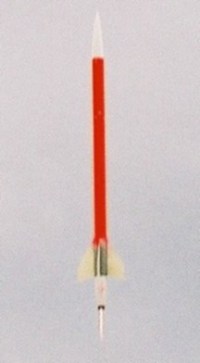R-DAS FLIGHT #5 DETAILS
Flight #: 5
Date: September, 2001
Venue: Elsworth, Cambridgeshire
R-DAS type: R-DAS Classic
R-DAS firmware: 3.0
R-DAS Recorded Altitude: 1504 feet (456 metres)
Apogee - Charge Firing Delta-t: 2.2 seconds
Apogee - Charge Firing Delta-h: 75 feet (22.7 metres)
Descent Rate at Apogee Deployment: 34 feet per second (10.3 metres per second)
Total Time of Flight: 55 seconds
Apogee - Charge Firing h Variance: 5%
R-DAS Flight Mode: Apogee & Main Ejection
Launch Vehicle Diameter: 2.6 inches
Launch Vehicle Length: 6 feet
Launch Vehicle Propulsion: R.A.T.T.Works I-80H Hybrid
Fins: 4 clipped swept deltas (Aerofoiled)
Launch System: Rail Launch (6 feet long, Black Sky Rail)
Finish: Largely painted, but some airframe unfinished
Ejection Method: Electronic Deployment using apogee charge in SafeEject canister, then main charge in SafeEject canister as backup
Ejection Ignition Type: Daveyfire igniters (electric matches)
|

|
 | | Comments The second flight of the Hytest-1 rocket went without a hitch. the ascent was very straight, and on the second flight, the 2-stage recovery system had been dispensed in favour of a single stage deployment system. The difference in length seemed to provide added stability on the ascent, and coupled with a lower wind speed at the launch site, resulted in the straight trajectory.
| |
 | | Thrust Section of Flight | |
|
 |
|
Mon, Jan 5, 2026, 09:02 GMT
(17)  7:34 7:34  16:03 16:03  57
% 57
% |
|
home - space - research - links - contact me - colophon
Richard Osborne - 1995-2006 |
|